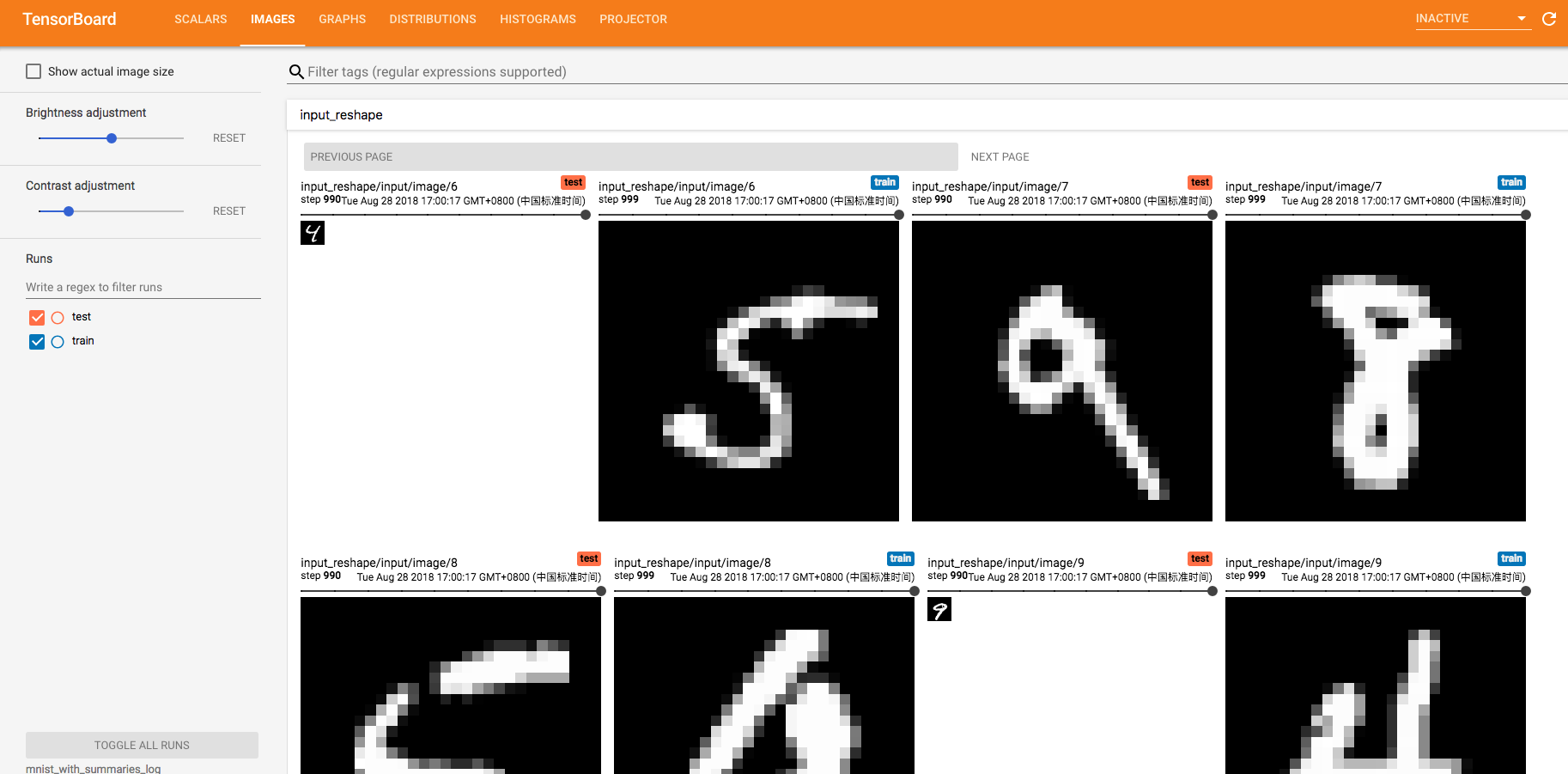tensor_board.py

#!/usr/bin/env python # -*- coding: utf-8 -*- """ @file tensor_board.py """ import tensorflow as tf from tensorflow.examples.tutorials.mnist import input_data max_steps = 1000 learning_rate = 0.001 dropout = 0.9 data_dir = 'MNIST_data' log_dir = 'mnist_with_summaries_log' mnist = input_data.read_data_sets(data_dir, one_hot = True) sess = tf.InteractiveSession() with tf.name_scope('input'): x = tf.placeholder(tf.float32, [None, 784], name='x-input') y_ = tf.placeholder(tf.float32, [None, 10], name ='y-input') with tf.name_scope('input_reshape'): image_shaped_input = tf.reshape(x, [-1, 28, 28, 1]) tf.summary.image('input', image_shaped_input, 10) def weight_variable(shape): initial = tf.truncated_normal(shape, stddev=0.1) return tf.Variable(initial) def biases_variable(shape): initial = tf.constant(0.1, shape=shape) return tf.Variable(initial) def variable_summaries(var): with tf.name_scope('summaries'): mean = tf.reduce_mean(var) tf.summary.scalar('mean', mean) with tf.name_scope('stddev'): stddev = tf.sqrt(tf.reduce_mean(tf.square(var - mean))) tf.summary.scalar('stddev', stddev) tf.summary.scalar('max', tf.reduce_max(var)) tf.summary.scalar('min', tf.reduce_min(var)) tf.summary.histogram('histogram', var) def nn_layer(input_tensor, input_dim, output_dim, layer_name, act=tf.nn.relu): with tf.name_scope(layer_name): with tf.name_scope('weights'): weights = weight_variable([input_dim, output_dim]) variable_summaries(weights) with tf.name_scope('biases'): biases = biases_variable([output_dim]) variable_summaries(biases) with tf.name_scope('Wx_plus_b'): preactivate = tf.matmul(input_tensor, weights) + biases tf.summary.histogram('preactivate', preactivate) activations = act(preactivate, name='activation') tf.summary.histogram('activations', activations) return activations hidden1 = nn_layer(x, 784, 500, 'layer1') with tf.name_scope('dropout'): keep_prob = tf.placeholder(tf.float32) tf.summary.scalar('dropout_keep_probability', keep_prob) dropped = tf.nn.dropout(hidden1, keep_prob) y = nn_layer(dropped, 500, 10, 'layer2', act=tf.identity) with tf.name_scope('cross_entropy'): diff = tf.nn.softmax_cross_entropy_with_logits(logits=y, labels=y_) with tf.name_scope('total'): cross_entropy = tf.reduce_mean(diff) tf.summary.scalar('cross_entropy', cross_entropy) with tf.name_scope('train'): train_step = tf.train.AdamOptimizer(learning_rate).minimize(cross_entropy) with tf.name_scope('accuracy'): with tf.name_scope('correct_prediction'): correct_prediction = tf.equal(tf.argmax(y, 1), tf.argmax(y_, 1)) with tf.name_scope('accuracy'): accuracy = tf.reduce_mean(tf.cast(correct_prediction, tf.float32)) tf.summary.scalar('accuracy', accuracy) merged = tf.summary.merge_all() train_writer = tf.summary.FileWriter(log_dir + '/train', sess.graph) test_writer = tf.summary.FileWriter(log_dir + '/test') tf.global_variables_initializer().run() def feed_dict(train): if train: xs, ys = mnist.train.next_batch(100) k = dropout else: xs, ys = mnist.test.images, mnist.test.labels k = 1.0 return {x: xs, y_: ys, keep_prob: k} saver = tf.train.Saver() for i in range(max_steps): if i % 10 == 0: summary, acc = sess.run([merged, accuracy], feed_dict=feed_dict(False)) test_writer.add_summary(summary, i) print('Accuracy at step %s: %s' % (i, acc)) else: if i % 100 == 99: run_options = tf.RunOptions(trace_level=tf.RunOptions.FULL_TRACE) run_metadata = tf.RunMetadata() summary, _ = sess.run([merged, train_step], feed_dict=feed_dict(True), options=run_options, run_metadata=run_metadata) train_writer.add_run_metadata(run_metadata, 'step%03d' % i) train_writer.add_summary(summary, i) saver.save(sess, log_dir + "/model.ckpt", i) print('Adding run metadata for', i) else: summary, _ = sess.run([merged, train_step], feed_dict=feed_dict(True)) train_writer.add_summary(summary, i) train_writer.close() test_writer.close() if __name__ == '__main__': #tensorboard --logdir=mnist_with_summaries_log --port=8008 pass
生成图表:
tensorboard --logdir=mnist_with_summaries_log --port=8008


